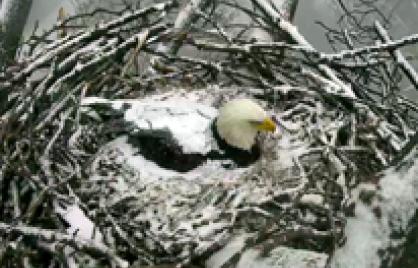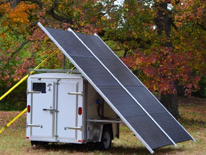
(WASHINGTON, DC) February 16, 2016 — Eagles have landed again at the U.S. National Arboretum, and for the first time, the public can view them via a pair of newly installed eagle nest cams. The bonded bald eagle pair has returned to the same nest where they successfully raised their eaglet last year. Dubbed “Mr. President” and “The First Lady,” they are the first mated pair to nest at the National Arboretum since 1947.
The eagle nest cams, which were installed by the American Eagle Foundation in cooperation with National Arboretum, can be viewed 24 hours a day at www.eagles.org/dceaglecam. The cameras are powered completely by a large solar array designed by Alfred State College, SUNY College of Technology, and were partially funded by the DOEE.
“We are honored to be a part of this exciting project that is connecting residents directly with our local wildlife,” said DOEE Director Tommy Wells. “That the eagles are breeding again this year—and are subsisting off fish caught in the Anacostia River—is a strong testament to the significant commitment the District has made to restoring and protecting our urban environment for future generations.”
 “These nest cameras give us an intimate look into the life of bald eagles in the nation’s capital,” said DOEE Wildlife Biologist Dan Rauch. “They are an invaluable tool for research and environmental education, as well as statement about the amazing wildlife in urban areas.”
“These nest cameras give us an intimate look into the life of bald eagles in the nation’s capital,” said DOEE Wildlife Biologist Dan Rauch. “They are an invaluable tool for research and environmental education, as well as statement about the amazing wildlife in urban areas.”
"The First Lady" laid her first egg of 2016 on February 10th and her second on February 14th. Both parents will carefully incubate the eggs, which are expected to hatch about 35 days after being laid.
Installing cameras protects the nesting pair by allowing people to view them while minimizing disturbances from park visitors. People, noise, and other distractions could cause the nesting pair to abandon their nest and eggs. Access to the area within approximately 660 feet around the nesting site is restricted during the critical nesting period.
CONTACT: Julia Robey Christian, PIO, (202) 741-0842 desk, (202) 450-7878 cell, [email protected]

